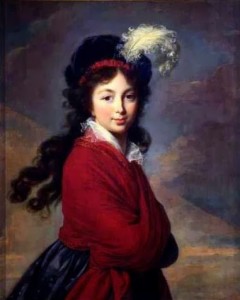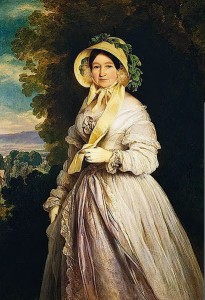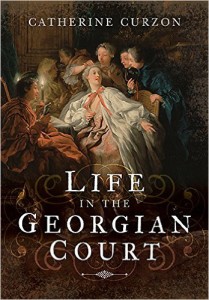 Relevant History welcomes Catherine Curzon, a royal historian who blogs on all matters 18th century. Her work has been featured by publications including BBC History Extra, All About History, History of Royals, Explore History and Jane Austen’s Regency World. She has performed at venues including the Royal Pavilion, Brighton, Lichfield Guildhall and Dr Johnson’s House. Catherine holds a Master’s degree in Film and when not dodging the furies of the guillotine, she lives in Yorkshire atop a ludicrously steep hill. Life in the Georgian Court is a privileged peek into the glamorous, tragic and iconic courts of the Georgian world. To learn more about her and her books, visit her blog, and follow her on Facebook, Twitter, Google+, Pinterest, and Instagram.
Relevant History welcomes Catherine Curzon, a royal historian who blogs on all matters 18th century. Her work has been featured by publications including BBC History Extra, All About History, History of Royals, Explore History and Jane Austen’s Regency World. She has performed at venues including the Royal Pavilion, Brighton, Lichfield Guildhall and Dr Johnson’s House. Catherine holds a Master’s degree in Film and when not dodging the furies of the guillotine, she lives in Yorkshire atop a ludicrously steep hill. Life in the Georgian Court is a privileged peek into the glamorous, tragic and iconic courts of the Georgian world. To learn more about her and her books, visit her blog, and follow her on Facebook, Twitter, Google+, Pinterest, and Instagram.
*****
There is nothing, for me, as thrilling as 18th century scandals. In the royal courts nothing was done by halves, from love to death to all the rich threads of drama that bind the legendary names of continental royalty together. Someone who knew all about drama was Princess Juliane of Saxe-Coburg, who was to become known as Grand Duchess Anna Feodorovna, wife of Grand Duke Constantine Pavlovich, a marriage that was destined to be anything but happy.
Juliane was born to Franz Frederick Anton, Duke of Saxe-Coburg-Saalfeld and his wife, Countess Augusta Caroline Reuss of Ebersdorf. With illustrious family connections throughout Europe, Juliane’s parents were determined that their daughter would continue to increase their dynastic influence and began searching for a husband for the girl, known for her beauty and her musical acumen. As they cast their eye over the royal houses of Europe, Empress Catherine II of Russia was likewise looking for a match for her grandson, Grand Duke Constantine. She was searching for a very particular sort of girl and dispatched General Andrei Budberg to compile a shortlist, the matter of marrying the second in line to the Russian empire a very serious one indeed.
The road to marriage
Taken ill whilst passing through Coburg, Budberg immediately added Juliane and her sisters, Sophie and Antoinette, to the list of likely candidates, much to the delight of their parents. However, not everybody shared their enthusiasm. For some there was disappointment that their own daughters had not been chosen whilst for others, the concept of a German princess marrying a Russian Duke was unthinkable, the young women viewed almost as lambs to the imperial slaughter.
 The three girls traveled to Russia with Countess Augusta and found themselves welcomed by Catherine, whilst Constantine was somewhat cooler in his reception. Far from keen on the idea of marriage to anybody, he eventually took his grandmother’s advice and agreed to marry Juliane, the 14 year old girl taking the name Anna Feodorovna in preparation for her new life. Baptised in a Russian Orthodox ceremony, the young Princess married the Duke on 26th February 1796, securing the strength of the Saxe-Coburg dynasty.
The three girls traveled to Russia with Countess Augusta and found themselves welcomed by Catherine, whilst Constantine was somewhat cooler in his reception. Far from keen on the idea of marriage to anybody, he eventually took his grandmother’s advice and agreed to marry Juliane, the 14 year old girl taking the name Anna Feodorovna in preparation for her new life. Baptised in a Russian Orthodox ceremony, the young Princess married the Duke on 26th February 1796, securing the strength of the Saxe-Coburg dynasty.
Although the marriage may have been politically astute, it was utterly miserable. Bad-tempered and disinterested in his wife, Constantine grew resentful of the young lady’s popularity at court, and he exercised a tight control over his bride. She was confined to her rooms, denied friends other than Elizabeth Alexeievna, and rarely appeared at court. Desperately unhappy, when Juliane fell ill in 1799, she seized the chance for escape with both hands.
Juliana traveled to Coburg, ostensibly for medical care, and initially intended to remain there but she found her family utterly unsupportive. Horrified at the damage a marital breakdown might do to the reputation and influence of the family, they pressured the Grand Duchess to return to her unhappy life in Russia. Once again she was confined to her rooms, utterly in the control of her husband and almost immediately, her health declined again.
Escape
By 1801 it became apparent that Juliane was in desperate need of a change of air and her mother finally consented to a trip back to Coburg. This time Juliane flatly refused to leave her native land and began divorce proceedings against Constantine. With the divorce hampered by legal and constitutional considerations, Juliane found unexpected support from the royal houses of Europe, their sympathies gained by the conduct of Constantine and his intransigent family. Trapped in a web of legality, the unhappy Grand Duchess indulged in extra-marital affairs and in 1808 gave birth to a son, Eduard Edgar Schmidt-Löwe. Four years later she had a daughter, Louise Hilda Agnes d’Aubert with Rodolphe Abraham de Schiferli, a Swiss surgeon.
 Though Constantine’s family constantly pursued a reconciliation between the estranged couple, Juliane utterly refused to even countenance it, the memory of her unhappy years in Russia too keen. Instead she made a life and home of her own in Switzerland, her house on the Aare River becoming a beacon of art and music. She and Rodolphe maintained a lifelong friendship, though their daughter was adopted by a French family in order to protect Juliane’s already somewhat tarnished reputation.
Though Constantine’s family constantly pursued a reconciliation between the estranged couple, Juliane utterly refused to even countenance it, the memory of her unhappy years in Russia too keen. Instead she made a life and home of her own in Switzerland, her house on the Aare River becoming a beacon of art and music. She and Rodolphe maintained a lifelong friendship, though their daughter was adopted by a French family in order to protect Juliane’s already somewhat tarnished reputation.
Nearly two decades after she fled to Coburg, Emperor Alexander I finally dissolved the marriage of Juliane and Constantine, allowing the Grand Duke to remarry. This small victory was followed by years of unhappiness as Juliane’s life was beset by tragedy. One after the other she was plunged into mourning for her parents and siblings, her illegitimate daughter and Rodolphe, her devoted friend and former lover. Juliane never quite recovered from these losses and lived on in quiet solitude, throwing herself into charitable works. Loved and respected by those who knew her, the princess passed away peacefully at home at the age of seventy-nine. She lived a life beset by scandal and unhappiness yet one cannot underestimate the strength it took to leave the powerful Russian court and strike out alone, resisting all efforts to force her back to the life she hated.
*****
 A big thanks to Catherine Curzon. She’ll give away a copy of Life in the Georgian Court to someone who contributes a comment on my blog this week. I’ll choose the winner from among those who comment by Friday at 6 p.m. ET. Delivery is available worldwide, and the winner may choose hardcover or ebook for the format.
A big thanks to Catherine Curzon. She’ll give away a copy of Life in the Georgian Court to someone who contributes a comment on my blog this week. I’ll choose the winner from among those who comment by Friday at 6 p.m. ET. Delivery is available worldwide, and the winner may choose hardcover or ebook for the format.
**********
Did you like what you read? Learn about downloads, discounts, and special offers from Relevant History authors and Suzanne Adair. Subscribe to Suzanne’s free newsletter.
